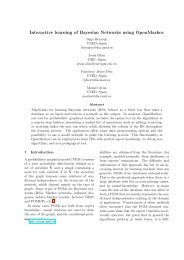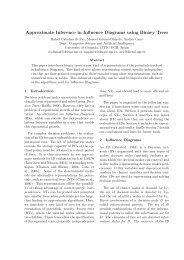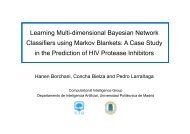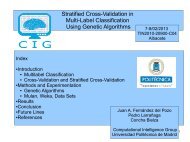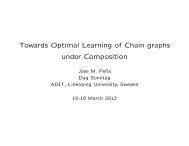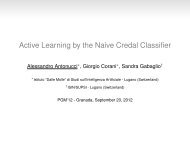elvira ii: aplicaciones de los modelos gr´aficos probabilÃsticos
elvira ii: aplicaciones de los modelos gr´aficos probabilÃsticos
elvira ii: aplicaciones de los modelos gr´aficos probabilÃsticos
Create successful ePaper yourself
Turn your PDF publications into a flip-book with our unique Google optimized e-Paper software.
ELVIRA II: APLICACIONES DE LOS MODELOS<br />
GRÁFICOS PROBABILÍSTICOS<br />
Aprendizaje <strong>de</strong> mo<strong>de</strong><strong>los</strong> gráficos probabilísticos. Aplicación al<br />
clustering con datos <strong>de</strong> expresión genética<br />
TIC 2001-2973-C05-03<br />
Departamento <strong>de</strong> Ciencias <strong>de</strong> la Computación e Inteligencia Artificial<br />
Universidad <strong>de</strong>l País Vasco<br />
http://www.sc.ehu.es/isg/<br />
Albacete · 18 <strong>de</strong> Junio 2002<br />
ELVIRA II: APLICACIONES DE LOS MODELOS GRÁFICOS PROBABILÍSTICOS– p.1/31
A. ELVIRA: Implementación y <strong>de</strong>sarrollo<br />
A.3 Preprocesamiento. Selección y transformación <strong>de</strong><br />
variables<br />
• 1. Selección indirecta, selección directa, selección<br />
híbrida<br />
• 2. Transformación <strong>de</strong> variables via construcción<br />
inductiva, via cambio <strong>de</strong> variables<br />
• 3. Imputación en bases <strong>de</strong> datos incompletas<br />
• 4. Categorización<br />
M1–M12: Estudio<br />
M13–M18: Implementación<br />
ELVIRA II: APLICACIONES DE LOS MODELOS GRÁFICOS PROBABILÍSTICOS– p.2/31
A. ELVIRA: Implementación y <strong>de</strong>sarrollo<br />
A.4 Aprendizaje<br />
• Aprendizaje con variables Gaussianas<br />
M1–M9: Estudio<br />
M10–M18: Implementación<br />
• Aprendizaje <strong>de</strong> re<strong>de</strong>s híbridas<br />
M10–M15: Estudio<br />
M16–M24: Implementación<br />
ELVIRA II: APLICACIONES DE LOS MODELOS GRÁFICOS PROBABILÍSTICOS– p.3/31
1. Selección indirecta, selección directa, selección híbrida<br />
• Motivación:<br />
• Gran<strong>de</strong>s bases <strong>de</strong> datos con información<br />
redundante y/o irrelevante<br />
• Construir mo<strong>de</strong><strong>los</strong> con mejores<br />
prestaciones, mediante la selección <strong>de</strong> las<br />
variables a<strong>de</strong>cuadas<br />
• Tres aproximaciones:<br />
• Selección indirecta<br />
• Selección directa<br />
• Selección híbrida<br />
ELVIRA II: APLICACIONES DE LOS MODELOS GRÁFICOS PROBABILÍSTICOS– p.4/31
1. Selección indirecta (filter approach)<br />
• Las variables se seleccionan, una vez or<strong>de</strong>nadas, en<br />
base a una medida que:<br />
• Tiene en cuenta las propieda<strong>de</strong>s intrínsecas <strong>de</strong> <strong>los</strong><br />
datos<br />
• No tiene en cuenta el algoritmo <strong>de</strong> clasificación<br />
supervisada (o no supervisada) a utilizar con<br />
posterioridad<br />
• El algoritmo <strong>de</strong> clasificación supervisada<br />
(naive–Bayes, C4.5, k–NN, Ripper, ...) o <strong>de</strong><br />
clasificación no supervisada (k–means, jerárquico<br />
ascen<strong>de</strong>nte, ...) se aplica a las variables seleccionadas<br />
ELVIRA II: APLICACIONES DE LOS MODELOS GRÁFICOS PROBABILÍSTICOS– p.5/31
1. Selección indirecta (filter approach)<br />
Clasificación supervisada<br />
• M. Ben–Bassat (1982) Use of distance<br />
measures, information measures and error<br />
bounds in feature evaluation. Handbook of<br />
Statistics, Vol. 2, 773–791.<br />
• H. Liu, H. Motoda (1998) Feature Selection<br />
for Knowledge Discovery and Data Mining.<br />
Kluwer Aca<strong>de</strong>mic Publishers.<br />
ELVIRA II: APLICACIONES DE LOS MODELOS GRÁFICOS PROBABILÍSTICOS– p.6/31
1. Selección indirecta (filter approach)<br />
Clasificación supervisada<br />
• Medidas <strong>de</strong> información (information gain)<br />
IG(X i , C) = −<br />
n c ∑<br />
j=1<br />
p(C = c j )log 2 p(C = c j )<br />
+<br />
n i ∑<br />
r=1<br />
n c<br />
p(X i = x r i ) ∑<br />
j=1<br />
p(C = c j | X i = x r i )log 2p(C = c j | X i = x r i )<br />
Mi<strong>de</strong> la reducción en incertidumbre en C motivada por<br />
el conocimiento <strong>de</strong> la variable X i<br />
ELVIRA II: APLICACIONES DE LOS MODELOS GRÁFICOS PROBABILÍSTICOS– p.7/31
1. Selección indirecta (filter approach)<br />
Clasificación supervisada<br />
• Medidas <strong>de</strong> distancia, separabilidad,<br />
divergencia o discriminación<br />
D(p(X i | C = c 1 ), p(X i | C = c 2 ))<br />
D(p(X i ), p(X i | C = c 1 ))+D(p(X i ), p(X i | C = c 2 ))<br />
Distancia entre dos distribuciones <strong>de</strong><br />
probabilidad a posteriori (dada la clase) o<br />
entre dos distribuciones <strong>de</strong> probabilidad una<br />
a priori, la otra a posteriori<br />
ELVIRA II: APLICACIONES DE LOS MODELOS GRÁFICOS PROBABILÍSTICOS– p.8/31
1. Selección indirecta (filter approach)<br />
Clasificación supervisada<br />
• Medidas <strong>de</strong> <strong>de</strong>pen<strong>de</strong>ncia, <strong>de</strong> asociación o <strong>de</strong><br />
correlación<br />
I(X i , C) =<br />
n i ∑<br />
n c ∑<br />
r=1 j=1<br />
p(X i = x r i , C = c j) log 2<br />
p(X i = x r i , C = c j)<br />
p(X i = x r i ) · p(C = c j)<br />
Cantidad <strong>de</strong> información mútua<br />
ELVIRA II: APLICACIONES DE LOS MODELOS GRÁFICOS PROBABILÍSTICOS– p.9/31
1. Selección indirecta (filter approach)<br />
Clasificación no supervisada. Criterio Univariante<br />
• Medida <strong>de</strong> relevancia <strong>de</strong> una variable<br />
R(X i ) =<br />
n∑<br />
j=1,j≠i<br />
−N log(1 − r 2 ij|resto )<br />
n − 1<br />
r ij|resto coeficiente <strong>de</strong> correlación parcial <strong>de</strong> X i y X j ajustado por<br />
el resto <strong>de</strong> las variables. R(X i ) medida <strong>de</strong> relevancia <strong>de</strong> X i .<br />
Cuanto mayor sea más relevante es la variable<br />
• J. M. Peña, J. A. Lozano, P. Larrañaga, I. Inza (2001)<br />
Dimensionality reduction in unsupervised learning of conditional<br />
Gaussian networks. IEEE PAMI, Vol. 23, No. 6, 590–603<br />
ELVIRA II: APLICACIONES DE LOS MODELOS GRÁFICOS PROBABILÍSTICOS– p.10/31
1. Selección indirecta (filter approach)<br />
Clasificación no supervisada. Criterio Multivariante<br />
• Seleccionar el conjunto S ∗ <strong>de</strong> variables que haga que:<br />
S ∗ = arg mín<br />
S<br />
D(M(N, N), D(M S (N, N))<br />
con<br />
• D(M(N, N)) matriz <strong>de</strong> distancias entre <strong>los</strong> N casos<br />
teniendo en cuenta todas las variables<br />
• D(M S (N, N)) matriz <strong>de</strong> distancias entre <strong>los</strong> N<br />
casos teniendo en cuenta las variables<br />
seleccionadas<br />
ELVIRA II: APLICACIONES DE LOS MODELOS GRÁFICOS PROBABILÍSTICOS– p.11/31
1. Selección directa (wrapper approach)<br />
Clasificación supervisada<br />
• Ligado a un método <strong>de</strong> clasificación pre<strong>de</strong>finido<br />
• La selección <strong>de</strong> variables vista como un proceso <strong>de</strong><br />
búsqueda<br />
• Cardinalidad <strong>de</strong>l espacio <strong>de</strong> búsqueda: 2 n<br />
• Cada subconjunto <strong>de</strong> variables candidato se evalúa<br />
por medio <strong>de</strong> un método <strong>de</strong> validación (K-fold,<br />
boostrapping, ...)<br />
• Búsqueda: voraz (hacia a<strong>de</strong>lante, hacia at´ás),<br />
estocástica<br />
ELVIRA II: APLICACIONES DE LOS MODELOS GRÁFICOS PROBABILÍSTICOS– p.12/31
1. Selección directa (wrapper approach)<br />
Clasificación no supervisada<br />
• Planteamiento <strong>de</strong>l problema<br />
• Encontrar el subconjunto <strong>de</strong> variables que nos<br />
proporcione un clustering lo más parecido posible<br />
al que se obtiene con todas las variables<br />
• Representación<br />
• Cada subconjunto como un array binario <strong>de</strong><br />
dimensión n<br />
• Bondad <strong>de</strong> cada selección<br />
• Porcentaje <strong>de</strong> coinci<strong>de</strong>ncia entre <strong>los</strong> clusterings<br />
ELVIRA II: APLICACIONES DE LOS MODELOS GRÁFICOS PROBABILÍSTICOS– p.13/31
1. Selección híbrida<br />
• 2 fases (filter + wrapper)<br />
• Or<strong>de</strong>nar las variables según un criterio.<br />
Escoger las k mejores (k < n). La<br />
<strong>de</strong>terminación <strong>de</strong> k es arbitraria, a no ser<br />
que el criterio siga una ley <strong>de</strong> probabilidad<br />
conocida (test <strong>de</strong> hipótesis)<br />
• Efectuar una selección wrapper sobre las k<br />
variables anteriores<br />
ELVIRA II: APLICACIONES DE LOS MODELOS GRÁFICOS PROBABILÍSTICOS– p.14/31
1. Selección híbrida<br />
• R. Blanco, P. Larrañaga, I. Inza, B. Sierra (2001)<br />
Selection of highly accurate genes for cancer<br />
classification by estimation of distribution algorithms.<br />
Workshop of Bayesian Mo<strong>de</strong>ls in Medicine. AIME2001,<br />
29–34<br />
• S. Das (2001) Filters, wrappers and a hybrid:<br />
evaluating feature selection algorithms. ICML2001,<br />
74–81<br />
• E. P. Xing, M. I. Jordan, R. M. Karp (2001) Feature<br />
selection for high–dimension genomic microarray data.<br />
ICML2001, 601–608<br />
ELVIRA II: APLICACIONES DE LOS MODELOS GRÁFICOS PROBABILÍSTICOS– p.15/31
2. Transformación <strong>de</strong> variables via construcción inductiva, via cambio <strong>de</strong> variable<br />
Construcción inductiva<br />
• Crear variables que sean producto cartesiano<br />
<strong>de</strong> 2 o más variables<br />
• Incorporar dichas variables (supernodos en<br />
un mo<strong>de</strong>lo <strong>de</strong> clasificación (supervisada o no<br />
supervisada) que extienda el naive–Bayes<br />
ELVIRA II: APLICACIONES DE LOS MODELOS GRÁFICOS PROBABILÍSTICOS– p.16/31
2. Construcción inductiva. Clasificación supervisada<br />
Pazzani, M. J. (1996) Searching for <strong>de</strong>pen<strong>de</strong>ncies in Bayesian<br />
classifiers. Learning from Data: AI and Statistics V. Lecture Notes in<br />
Statistics 112. D. Fisher, H.-J. Lenz (eds.), Springer-Verlag.<br />
• 2 procedimientos voraces <strong>de</strong> búsqueda:<br />
• Backward sequential elimination and joining (BSEJ): parte <strong>de</strong>l<br />
naive–Bayes con todas las variables, y en cada paso junta o<br />
elimina<br />
• Forward sequential selection and joining (FSSJ): parte <strong>de</strong><br />
• Scores<br />
nada y en cada paso selecciona o junta<br />
• Porcentaje <strong>de</strong> bien clasificados<br />
• Verosimilitud marginal<br />
ELVIRA II: APLICACIONES DE LOS MODELOS GRÁFICOS PROBABILÍSTICOS– p.17/31
2. Construcción inductiva. Clasificación no supervisada<br />
Peña, J. M., Lozano, J. A., Larrañaga, P. (1999)<br />
Learning Bayesian networks for clustering by<br />
means of constructive induction. Pattern<br />
Recognition Letters, 20 (11–13), 1219–1230<br />
• Adaptación <strong>de</strong> las i<strong>de</strong>as <strong>de</strong> Pazzani al<br />
clustering<br />
• Búsqueda: BSEJ, FSSJ<br />
• Score: verosimilitud marginal<br />
ELVIRA II: APLICACIONES DE LOS MODELOS GRÁFICOS PROBABILÍSTICOS– p.18/31
2. Cambio <strong>de</strong> variable<br />
H. Liu, H. Motoda (1998) Feature extraction, construction<br />
and selection. A data mining perspective. Kluwer<br />
Aca<strong>de</strong>mic Publishers.<br />
• Dado un conjunto <strong>de</strong> N condiciones:<br />
• M − of − N representación: será true si al menos<br />
M <strong>de</strong> las N condiciones son verificadas por el caso<br />
• 1 − of − N representación: disyunción<br />
• N − of − N representación: conjunción<br />
• X − of − N representación: será true si<br />
exactamente X <strong>de</strong> las N condiciones son<br />
verificadas por el caso<br />
ELVIRA II: APLICACIONES DE LOS MODELOS GRÁFICOS PROBABILÍSTICOS– p.19/31
3. Imputación <strong>de</strong> bases <strong>de</strong> datos incompletas<br />
Algoritmo EM (Expectation–Maximization)<br />
• Demspter, A. P., laird, N. M., Rubin, D. B. (1977)<br />
Maximum likelihood from incomplete data via the EM<br />
algorithm. Journal of the Royal Statistical Society B,<br />
39(1): 1–38<br />
• McLachlan, G. J., Krishnan, T. (1997) The EM<br />
Algorithm and Extensions. John Wiley and Sons<br />
• Lauritzen S. L. (1995) The EM algorithm for graphical<br />
association mo<strong>de</strong>ls with missing data. Computational<br />
Statistics and Data Analysis, 19: 191–201<br />
ELVIRA II: APLICACIONES DE LOS MODELOS GRÁFICOS PROBABILÍSTICOS– p.20/31
3. Algoritmo EM (Expectation–Maximization)<br />
• X variable multinomial con cinco posibles<br />
valores: x 1 , x 2 , x 3 , x 4 , x 5<br />
• p(X = x 1 ) = 1/2<br />
• p(X = x 2 ) = θ/4<br />
• p(X = x 3 ) = (1 − θ)/4<br />
• p(X = x 4 ) = (1 − θ)/4<br />
• p(X = x 5 ) = θ/4<br />
con 0 < θ < 1<br />
ELVIRA II: APLICACIONES DE LOS MODELOS GRÁFICOS PROBABILÍSTICOS– p.21/31
3. Algoritmo EM (Expectation–Maximization)<br />
• En una muestra <strong>de</strong> tamaño N, se obtiene que<br />
<strong>los</strong> 5 valores anteriores se han dado:<br />
N 1 , N 2 , N 3 , N 4 , N 5 veces. N = ∑ 5<br />
i=1 N i<br />
• La verosimilitud <strong>de</strong> la muestra es<br />
proporcional a:<br />
(1/2) N 1<br />
(θ/4) N 2<br />
((1 − θ)/4) N 3<br />
((1 − θ)/4) N 4<br />
(θ/4) N 5<br />
• El EMV para θ es: ˆθ =<br />
(N 2 +N 5 )<br />
(N 2 +N 3 +N 4 +N 5 )<br />
ELVIRA II: APLICACIONES DE LOS MODELOS GRÁFICOS PROBABILÍSTICOS– p.22/31
3. Algoritmo EM (Expectation–Maximization)<br />
• Supongamos ahora que no tenemos N1 y N 2 y que en su lugar nos dan el valor<br />
<strong>de</strong> M 1+2 = N 1 + N 2 . Denotamos: M 3 = N 3 , M 4 = N 4 , M 5 = N 5<br />
• Utilizando el siguiente procedimiento iterativo, po<strong>de</strong>mos buscar una aproximación<br />
para ˆθ<br />
• 1. Dado un valor inicial para θ, usamos <strong>los</strong> valores observados<br />
M 1+2 , M 3 , M 4 , M 5 para estimar <strong>los</strong> valores esperados para N 1 y N 2 :<br />
N 1 = M 1+2<br />
1/2<br />
1/2 + θ/4<br />
N 2 = M 1+2<br />
θ/4<br />
1/2 + θ/4<br />
• 2. Usamos la estimación <strong>de</strong> <strong>los</strong> datos completos para revisar nuestra<br />
estimación sobre θ, por medio <strong>de</strong> la fórmula <strong>de</strong> su estimación máximo<br />
verosímil<br />
• 3. Alternamos <strong>los</strong> dos pasos anteriores hasta condición <strong>de</strong> parada<br />
ELVIRA II: APLICACIONES DE LOS MODELOS GRÁFICOS PROBABILÍSTICOS– p.23/31
3. Algoritmo EM (Expectation–Maximization)<br />
Partiendo <strong>de</strong> θ = 0,5 y M 1+2 = 125, M 3 = 18, M 4 = 20, M 5 = 34 se<br />
obtiene:<br />
Iteración<br />
θ<br />
0 0.500000000<br />
1 0.608247423<br />
2 0.624321051<br />
3 0.626488879<br />
4 0.626777323<br />
5 0.626815632<br />
6 0.626820719<br />
7 0.626821395<br />
8 0.626821484<br />
ELVIRA II: APLICACIONES DE LOS MODELOS GRÁFICOS PROBABILÍSTICOS– p.24/31
3. Algoritmo EM (Expectation–Maximization)<br />
• Paso <strong>de</strong> expectation: estimar <strong>los</strong> datos<br />
incompletos a partir <strong>de</strong> sus valores<br />
esperados obtenidos a partir <strong>de</strong> <strong>los</strong><br />
estimadores actuales <strong>de</strong> <strong>los</strong> parámetros<br />
• Paso <strong>de</strong> maximization: usando las<br />
complexiones <strong>de</strong> <strong>los</strong> datos incompletos,<br />
tratar<strong>los</strong> como completos y estimar por<br />
máxima verosimilitud <strong>los</strong> parámetros<br />
ELVIRA II: APLICACIONES DE LOS MODELOS GRÁFICOS PROBABILÍSTICOS– p.25/31
3. Algoritmo EM (Expectation–Maximization)<br />
Propieda<strong>de</strong>s:<br />
• La sucesión <strong>de</strong> estimadores obtenidos con el<br />
EM genera una sucesión <strong>de</strong> verosimilitu<strong>de</strong>s<br />
creciente. Si dicha sucesión está acotada<br />
superiormente, converge hacia cierto valor<br />
• Bajo ciertas condiciones <strong>de</strong> regularidad dicho<br />
valor es un m´ximo local <strong>de</strong> la función <strong>de</strong><br />
verosimilitud<br />
ELVIRA II: APLICACIONES DE LOS MODELOS GRÁFICOS PROBABILÍSTICOS– p.26/31
3. Algoritmo EM (Expectation–Maximization)<br />
• En re<strong>de</strong>s Bayesianas el paso E (expectation)<br />
trae como consecuencia el tener que partir el<br />
caso<br />
• Lo habitual suele ser completarlo bien con:<br />
• El valor modal (versión <strong>de</strong>terminista)<br />
• Un valor obtenido por simulación (versión<br />
estocástica)<br />
• Experiencia en el grupo en la aplicación <strong>de</strong>l<br />
EM al problema <strong>de</strong>l clustering con mo<strong>de</strong><strong>los</strong><br />
gráficos probabilísticos. Variable hid<strong>de</strong>n no<br />
observada<br />
ELVIRA II: APLICACIONES DE LOS MODELOS GRÁFICOS PROBABILÍSTICOS– p.27/31
3. Algoritmo BC (Bound and Collapse)<br />
M. Ramoni, P. Sebastiani (1997) Learning Bayesian<br />
networks from incomplete databases. UAI’97, 401–408<br />
• Método <strong>de</strong>terminista que actúa en dos fases:<br />
• Primera fase: acota el conjunto <strong>de</strong> posibles valores<br />
para el parámetro en un intervalo. El máximo y el<br />
mínimo valor <strong>de</strong>l mismo <strong>de</strong>ben <strong>de</strong> ser consistentes<br />
con <strong>los</strong> datos<br />
• Segunda fase: colapsa el máximo y el mínimo en<br />
un punto, por medio <strong>de</strong> una combinación convexa<br />
<strong>de</strong> dichos puntos extremos<br />
ELVIRA II: APLICACIONES DE LOS MODELOS GRÁFICOS PROBABILÍSTICOS– p.28/31
4. Categorización<br />
Clasificación <strong>de</strong> métodos <strong>de</strong> discretización <strong>de</strong>s<strong>de</strong> una<br />
triple perspectiva:<br />
• Global versus local<br />
• Supervisados versus no supervisados. En función <strong>de</strong><br />
que usen o no la variable clase<br />
• Estáticos versus dinámicos. En <strong>los</strong> estáticos el número<br />
<strong>de</strong> interva<strong>los</strong> para cada variable se fija <strong>de</strong> antemano o<br />
bien se <strong>de</strong>termina <strong>de</strong>spués <strong>de</strong> una única lectura <strong>de</strong> la<br />
base <strong>de</strong> datos<br />
ELVIRA II: APLICACIONES DE LOS MODELOS GRÁFICOS PROBABILÍSTICOS– p.29/31
4. Categorización<br />
Fayyad, U. M., Irani, K. B. (1993) Multi–interval discretization of<br />
continuous–valued attributes for classification learning. IJCAI’93,<br />
1022–1027<br />
• Particionamiento recursivo <strong>de</strong> mínima entropía<br />
• Local, supervisado, estático<br />
• Usa la entropía <strong>de</strong> la variable clase, calculada en las<br />
particiones candidatas, para seleccionar las fronteras <strong>de</strong> la<br />
discretización<br />
• T ∗ = arg mín |S 1|<br />
|S| Ent(S 1) + |S 2|<br />
|S| Ent(S 2)<br />
• El método se aplica recursivamente<br />
• Criterio <strong>de</strong> parada basado en ganancia <strong>de</strong> información en<br />
conjunción con MDL<br />
ELVIRA II: APLICACIONES DE LOS MODELOS GRÁFICOS PROBABILÍSTICOS– p.30/31
4. Categorización<br />
Propuesta: global, no supervisado, estático<br />
• Fijar <strong>de</strong>s<strong>de</strong> el inicio el número <strong>de</strong> interva<strong>los</strong> para cada<br />
variable<br />
• Buscar <strong>los</strong> puntos <strong>de</strong> corte <strong>de</strong> todas las variables al<br />
unísono, por medio <strong>de</strong> un heurístico estocástico<br />
• Evaluar cada posible combinación <strong>de</strong> puntos <strong>de</strong> corte<br />
por medio <strong>de</strong> la verosimilitud penalizada que se<br />
obtiene al apren<strong>de</strong>r una red Bayesiana (con el<br />
algoritmo K2) sobre el fichero <strong>de</strong> casos categorizados<br />
obtenido<br />
ELVIRA II: APLICACIONES DE LOS MODELOS GRÁFICOS PROBABILÍSTICOS– p.31/31



